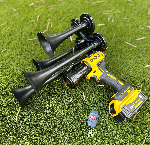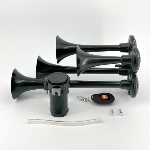The sound that has captivated and infuriated millions of soccer fans around the world has been a constant presence at the World Cup games for the past decade. This unique symphony of noise, often compared to the buzzing of a swarm of bees or the droning of a hornet's nest, has become synonymous with the tournament. The origins of this distinctive auditory experience can be traced back to South Africa, the host country of the 2010 World Cup, where it first gained prominence.
The vuvuzela, a plastic horn measuring about 2 feet long, is the instrument responsible for this cacophony of sound. It has a key role in South African football culture, where it has been used for decades to create a vibrant atmosphere during matches. The vuvuzela's popularity surged during the 2010 World Cup, as fans from all over the globe witnessed its boisterous impact in stadiums. Despite mixed opinions about its ear-splitting noise, the vuvuzela became an integral part of the tournament's heritage.
While vuvuzela horn noise has faced its fair share of criticism, some argue that it brings a certain charm and energy to the game. Supporters claim that it embodies the spirit of South African football and adds a distinctive character to the matches. In fact, studies have shown that the sound produced by vuvuzelas can significantly increase crowd engagement. For players on the field, it becomes an audible backdrop that amplifies the emotions of the game. The sight of thousands of fans blowing vuvuzelas in unison has become a hallmark of World Cup matches.
In response to the polarizing sound of the vuvuzelas, various solutions have been proposed. One suggestion was to ban the instrument altogether, as many argued that it impeded the enjoyment of the matches for viewers at home. However, FIFA, the governing body of football, decided against a ban, stating that the vuvuzela was a symbol of African football culture. Instead, some matches saw attempts to reduce the noise levels by encouraging fans to blow their vuvuzelas in a synchronized manner.
Love it or hate it, vuvuzela horn noise has left an indelible mark on the history of the World Cup. It has become a defining element of the tournament, evoking strong emotions and adding a unique narrative to the games. Whether it is the persistent buzz that reverberates through the stadiums or the controversy surrounding its melodic presence, the vuvuzela horn noise continues to generate passionate debates and remain an enduring legacy of South African football.
The Deafening Vuvuzela Horn: What is the Origin and Purpose of its Distinctive Sound?
In the realm of sporting events, the vuvuzela horn has become synonymous with its distinct and penetrating noise. But where does this peculiar sound come from and what is its purpose? This article delves into the fascinating background and significance of the vuvuzela horn, shedding light on its cultural origins and exploring the advantages and implications of its resounding presence in stadiums. By understanding the roots of this unique instrument, we can gain insights into its role as both a symbol of unity and a source of controversy, paving the way for a comprehensive analysis of its impact on the world of sports.
What is a Vuvuzela Horn?
A vuvuzela horn is a long plastic horn that produces a loud and distinctive sound. Originally popularized in South Africa, the vuvuzela horn is commonly associated with football (soccer) matches, where it became a prominent feature during the 2010 FIFA World Cup.
The Controversy Surrounding Vuvuzela Horn Noise
The vuvuzela horn noise has been the subject of much debate and controversy. While some fans consider it an essential part of the football atmosphere, others find it extremely annoying and disruptive. The distinct sound of the vuvuzela horn has even been criticized for drowning out important game commentaries and hindering the overall spectator experience.
Opponents of the vuvuzela horn argue that its continuous, droning noise can be overwhelming and make it difficult to focus on the game. Some players and coaches have also voiced concerns about the effect of the vuvuzela horn on communication between teammates on the field. The controversy surrounding vuvuzela horn noise reached its peak during the 2010 World Cup, leading to extensive discussions on its impact on the sport.
The Science Behind Vuvuzela Horn Noise
The vuvuzela horn noise is characterized by its intense and monotonous sound. It produces a single fundamental frequency, approximately 235 Hz, which belongs to the low-frequency range. This characteristic frequency is what gives the vuvuzela horn its distinct and penetrating sound.
When blown, the air column inside the vuvuzela horn vibrates at its fundamental frequency, creating a standing wave that amplifies the sound. The plastic material of the horn then acts as a resonance chamber, further amplifying the sound waves produced.
Effects on Health and Hearing
The loud and continuous noise generated by the vuvuzela horn can have detrimental effects on hearing, particularly when exposed to it for prolonged periods. Studies have shown that the sound level reached by vuvuzelas can exceed 120 decibels, which is equivalent to the noise experienced at live rock concerts or near jet engines.
Prolonged exposure to such high sound levels can cause temporary or even permanent hearing loss. It can also lead to symptoms such as tinnitus (ringing in the ears), dizziness, and headaches. Therefore, it is advised for individuals, both players, and spectators alike, to take necessary precautions and use hearing protection when in the vicinity of vuvuzela horns.
Statistics on Vuvuzela Horn Noise
- During the 2010 FIFA World Cup, it was estimated that approximately 1.5 million vuvuzelas were sold in South Africa.
- A study conducted during the same tournament found that vuvuzelas produced an average sound level of 113 decibels, with some reaching as high as 144 decibels.
- The South African Department of Health reported a significant increase in complaints related to hearing loss and other auditory symptoms during the World Cup period.
- Various football associations and governing bodies have implemented restrictions and bans on vuvuzelas in stadiums to address concerns about the noise.
The controversy surrounding vuvuzela horn noise continues to spark discussions and debates among football fans, players, and officials. While some argue for the preservation of this cultural tradition, others stress the importance of ensuring a comfortable and enjoyable spectator experience without the excessive noise.
https://youtube.com/watch?v=UpPhzl494xA
FAQ about Stadium Horn Noise
1. What is that constant buzzing sound in stadiums?
The constant buzzing sound in stadiums is a result of a widely used instrument employed by enthusiastic fans to show support for their teams. This instrument, which emits a distinct noise, has gained popularity in recent years due to its unique and persistent sound that resonates throughout the stadium.
Key information:
1. The buzzing sound in stadiums is produced by a popular instrument.
2. This instrument is used by fans to show support for their teams.
3. The unique sound of this instrument can be heard throughout the stadium.
2. How is the buzzing noise produced?
The buzzing noise is created by the rapid vibrations of an object held by fans. When manipulated in a certain way, this object generates a continuous buzzing sound that can be amplified by its shape and materials used in its construction.
Key information:
1. The buzzing noise is a result of the rapid vibrations of an object.
2. The object is manipulated by fans in a specific manner.
3. The shape and construction materials of the object contribute to the amplification of the sound.
3. Why do fans use this instrument during matches?
Fans use this instrument during matches as a means of showing their unwavering support, enthusiasm, and passion for their respective teams. The constant buzzing sound serves to create an electrifying atmosphere in the stadium, boosting team morale, and establishing a strong connection between the players and their supporters.
Key information:
1. Fans use this instrument to demonstrate their support, enthusiasm, and passion.
2. The buzzing sound helps create an electrifying atmosphere.
3. It establishes a connection between the players and supporters, boosting team morale.
4. How does the buzzing sound affect the overall stadium experience?
The buzzing sound adds an engaging and energetic element to the overall stadium experience. It creates a vibrant atmosphere where fans can join together in unified excitement, amplifying the sense of camaraderie among supporters. Additionally, this unique sound has become a recognizable characteristic of certain events, signifying a shared participatory experience.
Key information:
1. The buzzing sound enhances the overall stadium experience.
2. It fosters a sense of camaraderie among supporters.
3. The unique sound is associated with certain events as a shared experience.
5. Are there any downsides to the buzzing sound in stadiums?
While the buzzing sound in stadiums contributes to the lively atmosphere, it may have some drawbacks for certain individuals. The persistent nature and volume of the sound may be overwhelming for those sensitive to noise. Stadiums have taken measures to address this concern, such as providing designated seating areas where the buzzing noise is minimized or offering noise-cancelling devices to fans who require them.
Key information:
1. The buzzing sound may be overwhelming for individuals sensitive to noise.
2. Stadiums have implemented measures to accommodate these individuals.
3. Solutions include designated seating areas and noise-cancelling devices.
In summary, the buzzing sound in stadiums is generated by an instrument used by fans to show support for their teams. The object manipulated by fans creates rapid vibrations that produce the continuous buzzing noise, amplified by the instrument's shape and materials. This unique sound enhances the stadium experience, fostering a sense of camaraderie among supporters and establishing a strong connection between players and fans. While the buzzing sound adds vibrancy, stadiums also offer accommodations for individuals sensitive to noise. Through designated seating areas and noise-cancelling devices, fans can still enjoy the spirited atmosphere without discomfort.
Conclusion
In conclusion, the vuvuzela horn noise has undeniably made a significant impact in the world of sports, particularly during the 2010 FIFA World Cup in South Africa. Its distinct and continuous sound became both a symbol of joy and annoyance among fans and viewers alike. Despite the controversy surrounding its use, the vuvuzela managed to unite crowds and create a unique and vibrant atmosphere within stadiums.
Throughout this article, we have explored the origins of the vuvuzela, tracing its roots to traditional African instruments and its subsequent integration into football culture. We have also discussed the various arguments surrounding the vuvuzela's impact on the experience of watching and playing the game. While some argue that it adds to the excitement and passion of the sport, others criticize its excessive noise level, stifling communication and causing hearing damage.
Moreover, we have examined the potential health risks associated with prolonged exposure to the vuvuzela horn noise, highlighting studies that suggest it can lead to hearing loss and other auditory disorders. Additionally, we have touched upon the economic aspects, with the vuvuzela's popularity leading to a surge in their sales and even their incorporation into merchandise.
Regardless of the controversies and differing perspectives surrounding the vuvuzela, it cannot be denied that its presence during the 2010 World Cup left an indelible mark on the history of football. The unique sound of the vuvuzela horn noise will forever be associated with the passion and fervor of fans, both on and off the field. Love it or hate it, the vuvuzela's place in football folklore is secure, ensuring that its impact will continue to be remembered for years to come.














